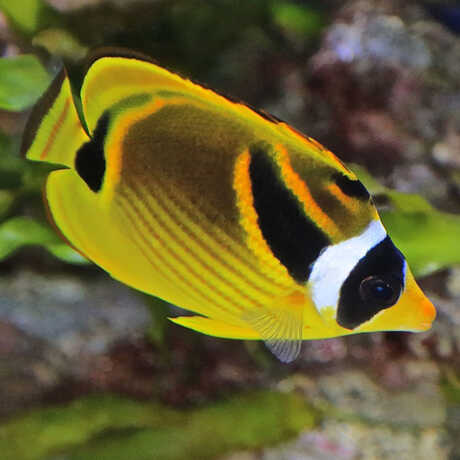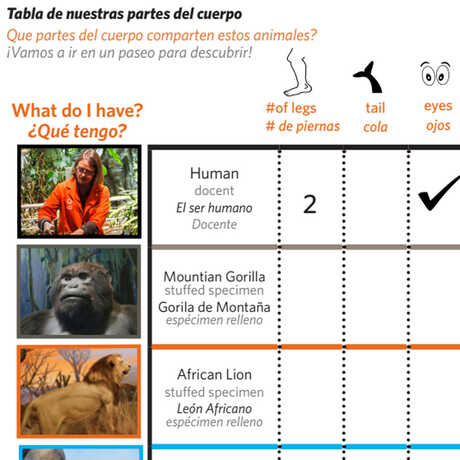
© Bob Mical
How does color help animals survive? Explore the Color of Life exhibit and find animals of every color. Try to figure out the functions of colors and discover similarities and differences in how color is used by different animals.
Students will be able to:
- identify colors of specimens and living animals in the Color of Life exhibit.
- explain the function of that color for the specimen or living animal; specifically whether that color helps the animal to hide, attract, or warn other creatures.
- a selection of free paint chips from your local paint or hardware store (2 different colors per student)
- It’s a Match! Scavenger Hunt (1 per student)
- It’s a Match! Chaperone Guide (1 per chaperone) scotch tape (1 roll per chaperone)
- a field trip reservation at the California Academy of Sciences
- Make a field trip reservation for the California Academy of Sciences online.
- Prior to your field trip, visit your local paint or hardware store and gather a selection of free paint chips. You can either select shades of the rainbow (red, orange, yellow, green, blue, violet, brown) or colors that match the specimens and living animals on display in the exhibit (see colors listed on the Chaperone Guide). Select 2 different colors for each student.
- Determine the number of chaperones you will have and assign groups of 4 to 6 students per chaperone.
- Print one copy of the It’s a Match! Chaperone Guide for each chaperone.
- Print one copy of the It’s a Match! Scavenger Hunt for each student.
- Pack 1 roll of scotch tape for each chaperone.
- Before your field trip, engage your students in a group brainstorm. Start by asking students to share their favorite color(s).
- Next, ask if they can tell you about an animal that is their favorite color.
- Ask students if they have any ideas about why that animal is that particular color. Does that color help the animal survive in some way? Does that color help it blend in with something in nature?
- Explain that animals can be different colors for many different reasons. In the broadest terms, color can help to hide, attract, or warn other creatures.
- Ask students if they can think of any other animals that are very good at hiding, attracting, or warning other creatures. Encourage students to look in picture books for ideas and examples.
- Tell students that they will be observing animals in the Color of Life exhibit at the California Academy of Sciences, and trying to figure out the purpose of color for different creatures.
- Upon your arrival at the museum, gather your students and chaperones in a large group next to the Color of Life exhibit. Teacher Tip: We recommend gathering everyone in the East Garden, outside of the exhibit. This is good meeting place for a large group, and your group will be out of the traffic flow on the museum floor.
- Tell students that they will be exploring the exhibit to see the wide array of colors that exist in the natural world. Remind students of your pre-visit discussion when they learned that color can help animals hide, attract, or warn other creatures. Tell students that they will be observing animals and specimens in the exhibit, and trying to figure out the purpose of color for different creatures.
- Explain the guidelines for their exploration:
- They will be working in groups of 4-6 students and one chaperone.
- Each student will have two different colored paint chips to use in their exploration of the exhibit.
- Students should find one living animal or specimen that matches each of their paint chips and record the color match on their worksheet (or have chaperones record it for them).
- Clarify for students that they should focus on finding living animals or specimens that match their paint chip colors. It is likely that students will find a picture or a sign that has a color match, but they should focus on finding the living animals or specimens in the exhibit. Also, the categories used in this activity do not include plants’ use of green pigments for photosynthesis, so groups should not focus on these matches.
- Once a student has found a color match, their small group should have brief discussion to decide whether that color helps the animal hide, attract, or warn others.
- After this discussion, the student should circle one of the options of the worksheet; either hide, attract, warn, or I don’t know.
- The chaperone can tape the paint chip onto the worksheet with scotch tape before moving on to the next match.
- Give chaperones the Chaperone Guide, worksheet, and scotch tape.
- Pass out 2 paint chips per student.
- Give groups 15-20 minutes to explore the exhibit and search for matches. Remind chaperones to watch the time and tell them where to meet up with you after the activity.
- Have the whole group come back together to share their results in a discussion. You have a couple options for how students and chaperones can share out on their exploration:
- Ask students to find a partner from another group. Have each partner use their worksheet to describe one color they matched to one specimen or living animal, and explain their reasoning for why the color helped it to hide, attract, or warn others.
- Ask each chaperone to share one color match for each student in their group, and whether the group thought that color helped the specimen or living animal hide, attract, or warn others.
- You can also discuss the following questions as a group:
- What colors were particularly easy to find in the exhibit? Which ones were difficult to find? Why?
- How did color help living things communicate with one another? Colors can be a signal that either attracts or repels mates, or indicates the age of the animal.
- Were there two animals in the exhibit that had the same color? If so, did the color serve the same purpose for both? The same color can serve different purposes on two different animals. For instance, a bright red frog can be a warning sign to predators that the tree frog is toxic. But a bright red male bird might be attractive to a female mate of the same species.
- Based on what you saw today, what other questions do you have about color?
Students can use their paint chips to explore other exhibits, such as the Philippine Coral Reef or the Rainforest exhibit, and identify more living things with those colors.
- color: the appearance of an object due to the light that it reflects
- predator: an animal that hunts and eats other animals
- prey: an animal that is hunted or caught for food
Our world is a vibrant and colorful place. From the seemingly endless shades of color in a bird’s plumage, to the iridescent shine of a beetle’s wings, the enormous diversity of colors that can be observed in the natural world is remarkable. In this activity, students will match the color of a specimen or living animal from the Color of Life exhibit to the color of a paint chip. They will work in small groups to determine the function of that color; specifically if that color helps to hide, attract, or warn others. This scavenger hunt is a student-led exploration that helps them to build their understanding of how the structure of an object (particularly its color) is related to its function, and that the same color can serve a different purpose for different living things.
There are three very general themes for the purpose or function a color can serve in the natural world. In the broadest terms, color may help to hide, attract, or warn other creatures. Not all living things fall into these categories, but they are general premises. Within the Color of Life exhibit, one can find many examples of specimens or living animals that fall under these three themes. The Chaperone Guide also provides an example of one living animal and one specimen or replica from the exhibit for each theme. Keep in mind that these examples are not the only animals that use color to hide, attract, or warn others.
Colors that hide: Many animals have evolved colors and patterns that blend into their habitats. A green lizard finds cover in a leafy tree canopy, while a sleeping owl’s speckled feathers match the bark of a tree. Patterns such as stripes and speckles on an animal’s exoskeleton, skin, or shell help to break up the body’s outline against the background. Prey have evolved these patterns to hide from predators, while predators have evolved similar camouflage to ambush prey.
Colors that attract: Animals belonging to the same species and different species can both use bright, vivid colors to communicate. Brilliant colors and dramatic ornaments can help females birds find the best mate. Sickly males often lack the energy to produce showy features, while a healthy male’s vivid skin or long tail feathers signal that he has good genes to pass on to his offspring. The bright hues of a flower’s petals are not just pretty colors. They are intended to attract pollinators, such as bees or birds, which help the plant reproduce. Often, these pollinators can see contrasting ultraviolet petal patterns, almost like landing lights that point the way to the flower’s nectar.
Colors that warn: If color could talk, it might growl a threat such as “back off.” Many animals that are harmful or unpleasant to eat have evolved colors and behaviors that stand out. It may take only one bad experience for a predator to learn a memorable lesson: to avoid eating creatures that advertise themselves as dangerous or disagreeable meals. For instance, the bright orange of a California newt reminds others that it packs a powerful poison—the toxin in a single newt could kill thousands of mice! Most predators know to steer clear of this amphibian. Even if an animal is not poisonous, they can still rely on color to warn their predators. One example of this is the Io moth. The drab, mottled pattern on the forewings of a female moth blends in with leaves or bark. If the moth is discovered, it snaps open its forewings to expose dark, menacing false eyes on the hind wings, which can startle or scare a predatory bird. This split second warning could mean a difference for the Io moth between being eaten and escaping alive.
Science and Engineering Practices
Obtaining, evaluating, and communicating information:
K-2: Read grade-appropriate texts and use media to obtain scientific and/or technical information to determine patterns in and/or evidence about the natural and designed world(s).
Communicate information or design ideas and/or solutions with others in oral and/or written forms using models, drawings, writing, or numbers that provide detail about scientific ideas, practices, and/or design ideas.
Crosscutting Concepts
Structure and Function:
K-2: The shape and stability of structures of natural and designed objects are related to their function(s).
Disciplinary Core Ideas
LS1.A: Structure and Function: All organisms have external parts. Different animals use their body parts in different ways to see, hear, grasp objects, protect themselves, move from place to place, and seek, find, and take in food, water and air. (1-LS1-1)
LS4.D: Biodiversity and Humans: There are many different kinds of living things in any area, and they exist in different places on land and in water. (2-LS4-1)
Related Performance Expectations
Remember, performance expectations are not a set of instructional or assessment tasks. They are statements of what students should be able to do after instruction. This activity or unit is just one of many that could help prepare your students to perform the following hypothetical tasks that demonstrate their understanding:
2-LS4-1. Make observations of plants and animals to compare the diversity of life in different habitats. [Clarification Statement: Emphasis is on the diversity of living things in each of a variety of different habitats.] [Assessment Boundary: Assessment does not include specific animal and plant names in specific habitats.]

